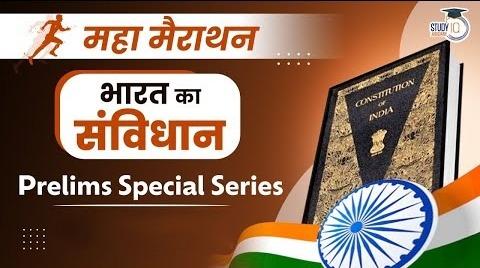Q) The Indian Constitution is dedicated to
A. the Constituent Assembly
B. the Parliament
C. the whole society
D. the people of India
Explanation:- D
Q) The constitution defines and determines the relation between
A. various Institutions and areas of government
B. Executive, the legislative and the Judiciary
C. Central Government, State Government and the local governments
D. all of the above
Explanation:- D
Q) The number of Articles and Schedules in original Indian Constitution was
A. 395 articles and 8 schedules
B. 394 articles and 9 schedules
C. 396 articles and 10 schedules
D. 395 articles and 7 schedules
Explanation:- A
Q) How many parts are present in the Indian Constitution
22 parts
B. 24 parts
C. 25 parts
D. 23 parts
Explanation:- A
Q) Who is known as the architect of the Constitution of independent India
A. Jawahar Lal Nehru
B. Rajendra Prasad
C. S. Radhakrishnan
D. BR Ambedkar
Explanation:- D
- Babasaheb Ambedkar’s legal expertise and knowledge of the Constitution of different countries was very helpful in the framing of the constitution. He became chairman of the Drafting Committee of the Constituent Assembly and played an important role in framing the Indian Constitution. Among others, his most important contributions were in areas of fundamental rights, strong central government and protection of minorities.
Q) The chairman of the constituent assembly was
A. Jawaharlal Nehru
B. Jayaprakash Narayan
C. C Rajagopalachari
D. Dr Rajendra Prasad
Explanation:- D
Q) On which of the following days the Constitution of India came into effect?
A. 26th November 1949
B. 26 January 1950
C. 26th March 1950
D. 26 April 1950
Explanation:- B
Q) “The Indian Constitution provides a unitary State with subsidiary Federal features, rather than Federal State with subsidiary unitary features”
A. Sir Ivor Jennings
B. AV dicey
C. Professor KC Wheare
D. S.A Desmith
Explanation:- C
Q) Which one of the following is not an essential characteristic of a federal constitution
A. Distribution of Powers
B. Supremacy of the Constitution
C. Presidential form of Government
D. Written constitution
Explanation:- C
Q) In which one of the following cases Supreme Court had held that States do not enjoy sovereignty under the Indian Constitution as it does not provide for a federal character in the strict sense –
A. Re berubari Union
B. State of West Bengal v. Union of India
C. State of Bombay v. RMD Chamarbaugwala
D. Shankari Prasad vs Union of India
Explanation:- B
- Federalism essentially means both the Centre and states have the freedom to operate in their allotted spheres of power, in coordination with each other. In the unitary system all powers of the Government are centralized in one Government that is Central Government. In the State of West Bengal vs Union of India (1962), the Supreme Court held that the Indian Constitution is not federal.
Q) India is called Democratic Republic because
A. State’s head is elected by the people
B. There is distribution of powers between the Centre and State
C. Parliament is Supreme
D. Judiciary is independent
Explanation:- A
Q) In Re Berubari and Exchange of Enclave the Supreme Court held that
A. Rule of law is not a part of constitution
B. Rule of law is a part of constitution
C. Preamble is not a part of constitution
D. Preamble is a part of constitution
Explanation:- C
Q) Which of the following statements is incorrect
A. The Preamble is a key to the understanding of the mind of the founding fathers
B. The Preamble embodies the ideals, hopes, faith and aspiration of the people
C. The Preamble embodies the intentions of the founding fathers and objective of the constitution
D. The Preamble of the Constitution has no importance it is no more than an introduction to the constitution
Explanation:- D
Q) Preamble of our Constitution is of extreme importance and the constitution should be read and interpreted in the light of the Grand and noble vision expressed in the Preamble- Justice Sikri expressed the above opinion in the case of
A. Re Berubari Union
B. Kesavananda Bharti vs State of Kerala
C. A K Gopalan vs State of Madras
D. In Re Kerala education bill
Explanation:- B
Q) In case there is a conflict between the Preamble and other provisions of the constitution which will prevail over the other
A. Preamble will prevail
B. other provision will prevail
C. both will go side-by-side
D. Interpretation of the supreme court will prevail
Explanation:- B
Q) Which one of the following statements is more correct
A. Preamble of the Constitution is the part of the constitution and can be amended under Article 368
B. Preamble of the Constitution is not a part of the constitution and cannot be amended
C. Preamble is the part of the constitution and can be amended only if no change in the basic structure is made
D. Preamble can be amended by Parliament simple majority
Explanation:- C
Q) In which case the Supreme Court held that secularism is a part of the basic structure of the Indian Constitution
A. Minerva Mills case
B. SR Bommai case
C. SP Gupta case
D. MC Mehta case
Explanation:- B
Q) The Preamble of the Indian Constitution has been amended so far
A. once
B. twice
C. thrice
D. never
Explanation:- A
Q) Preamble was amended by which amendment
A. 42nd amendment
B. 44th Amendment
C. 39th amendment
D. none of the above
Explanation:- A
- It was done in the year 1976. Added three new words (i.e., socialist, secular and integrity) in the Preamble.
Download| Free PDF






















 WhatsApp
WhatsApp